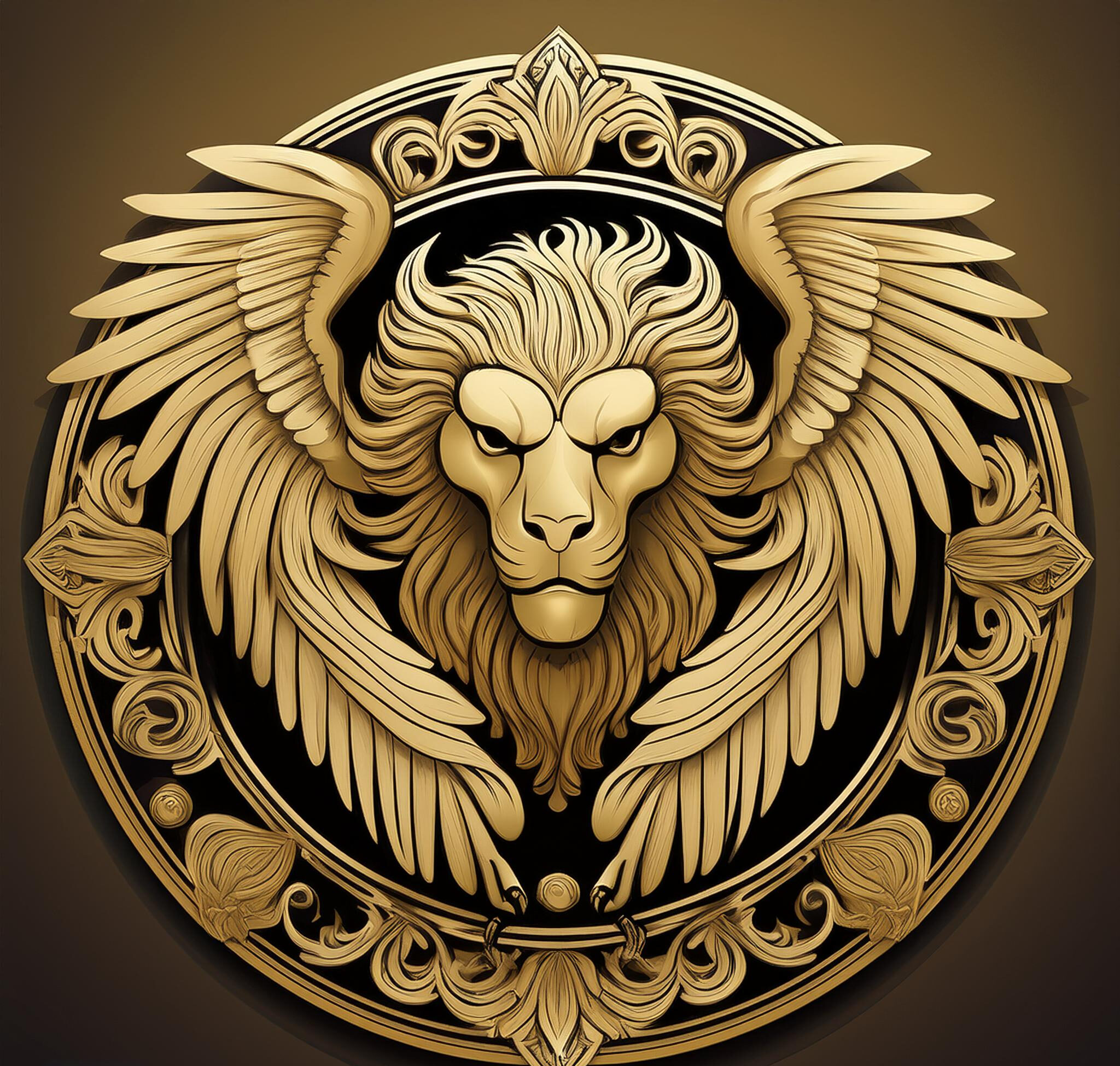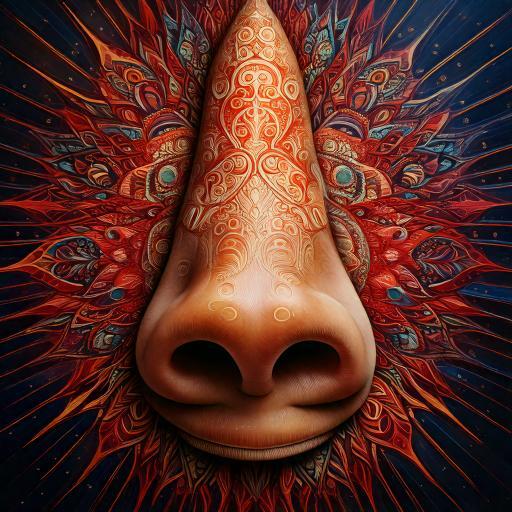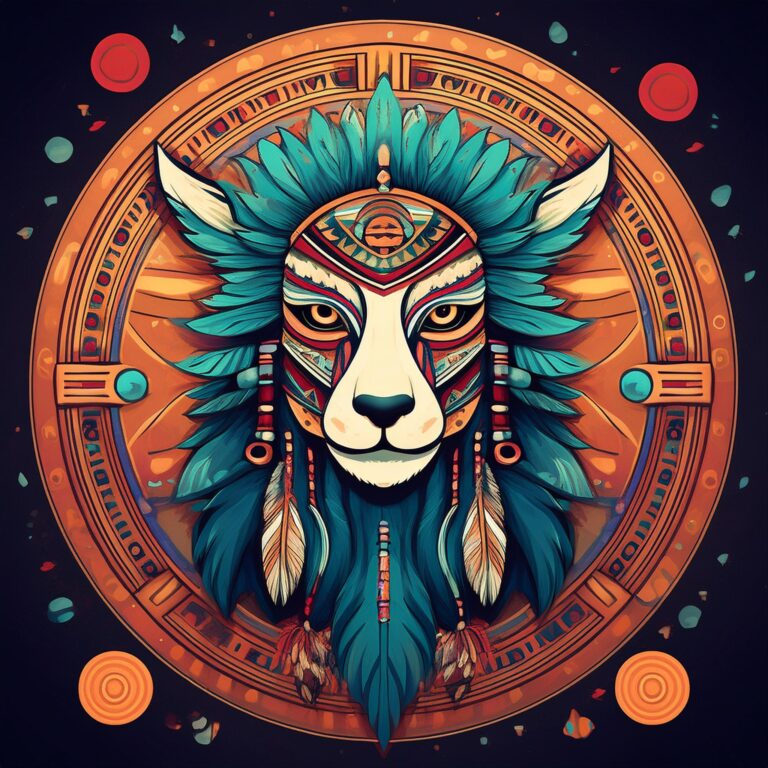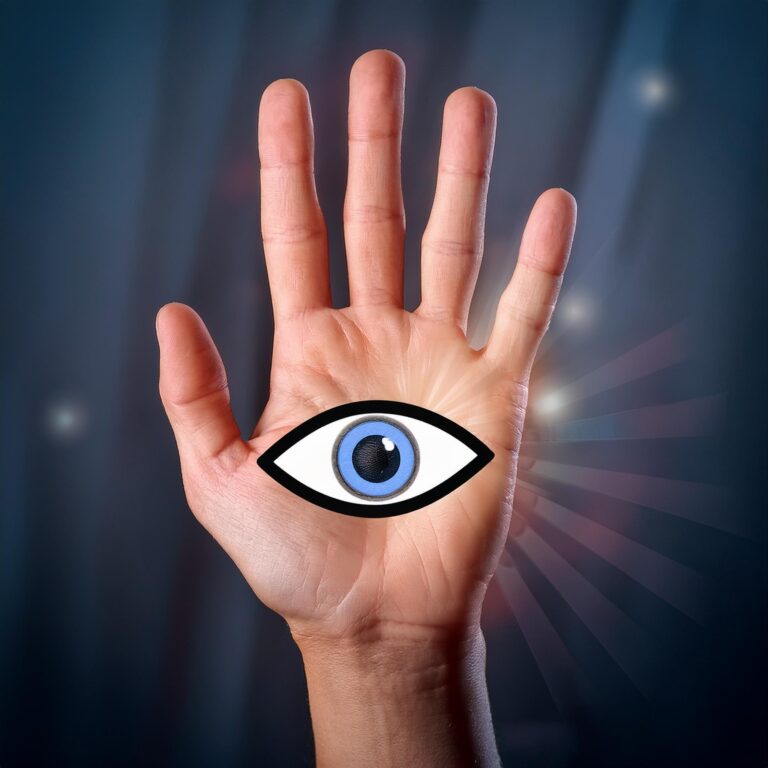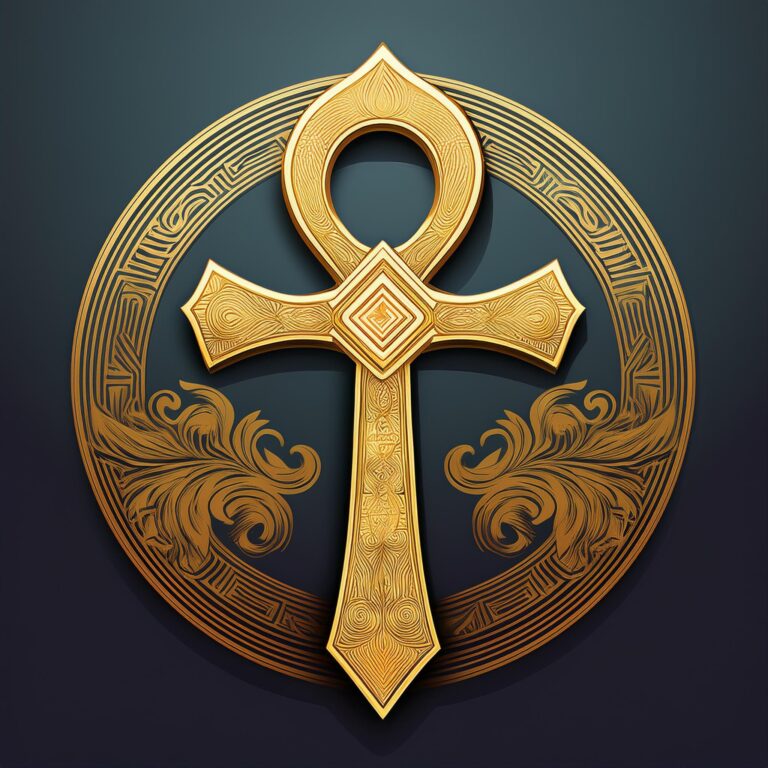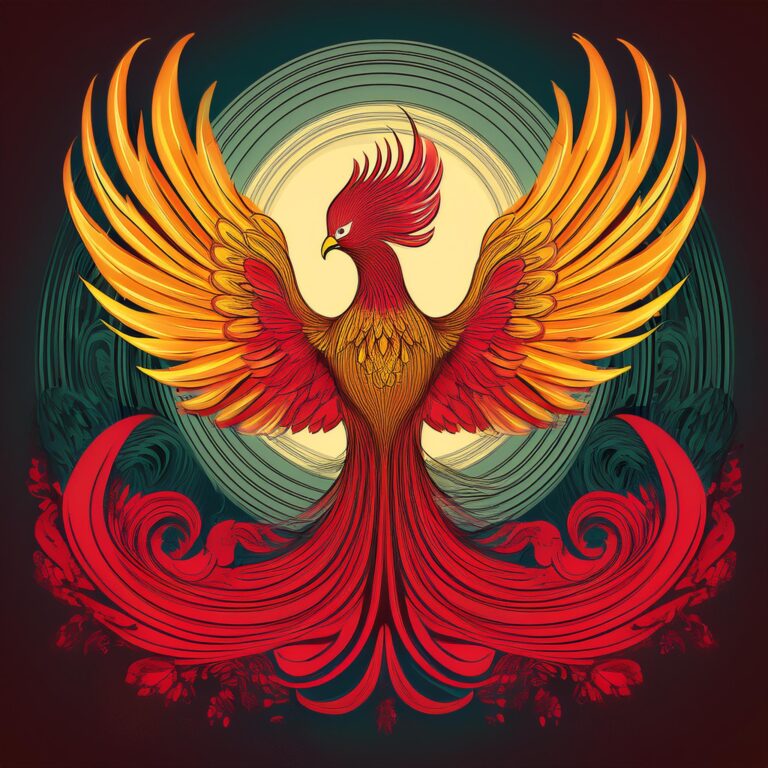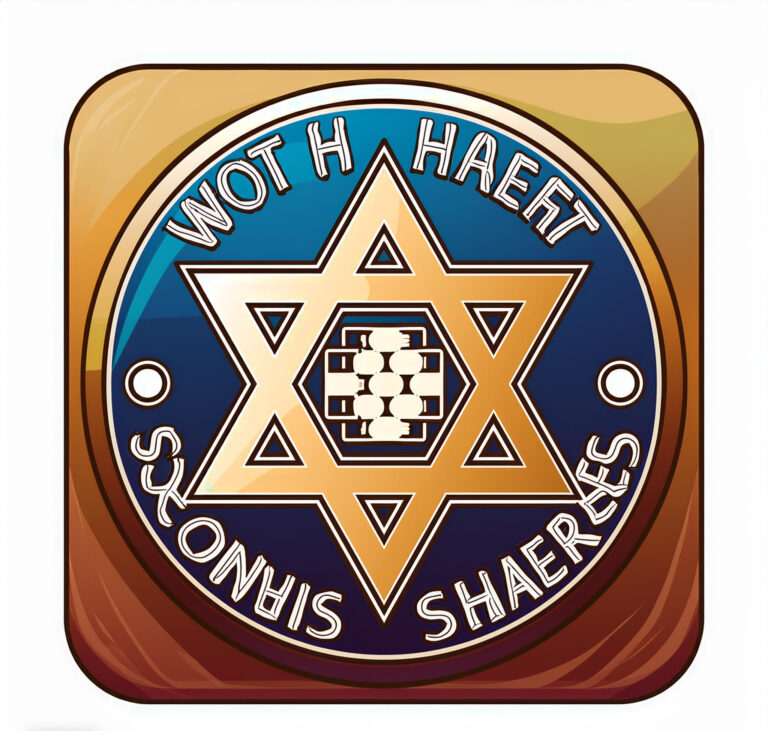The griffin is a powerful and majestic creature found in mythology, depicted as having the body of a lion and the head and wings of an eagle. This unique combination of two of the animal kingdom’s most revered creatures has made the griffin a symbol of strength, courage, and guardianship across various cultures throughout history.
Strength and Dominion:
The lion, known as the king of beasts, symbolizes strength, leadership, and authority. The eagle, often considered the king of birds, represents vision, freedom, and the divine. Together, the griffin embodies the qualities of both animals, making it a potent symbol of dominion and power. This dual nature highlights the balance between earthly and spiritual realms, suggesting that the griffin possesses control over both land and sky.
Protection and Guardianship:
Griffins were often depicted as protectors of treasures and sacred sites. In many myths, they are portrayed as fierce guardians, capable of warding off evil and protecting the weak. This protective nature has led to the griffin being associated with guardianship, vigilance, and a strong sense of duty.
Divine Power and Authority:
In ancient cultures, the griffin was seen as a divine creature, often linked to the gods. Its regal and awe-inspiring appearance made it a symbol of divine power and authority. This connection to the divine further solidified the griffin’s role as a symbol of supreme power and protection.
Wisdom and Enlightenment:
The eagle’s keen sight and ability to soar to great heights also lend the griffin a symbolic connection to wisdom and enlightenment. The griffin is often seen as a creature that not only protects but also guides, representing a source of knowledge and insight.
In summary, the griffin is a symbol rich in meaning, embodying the best qualities of both the lion and the eagle. Its symbolism spans strength, protection, divine power, and wisdom, making it one of the most revered and multifaceted creatures in mythology.
The Origins of the Griffin Symbol
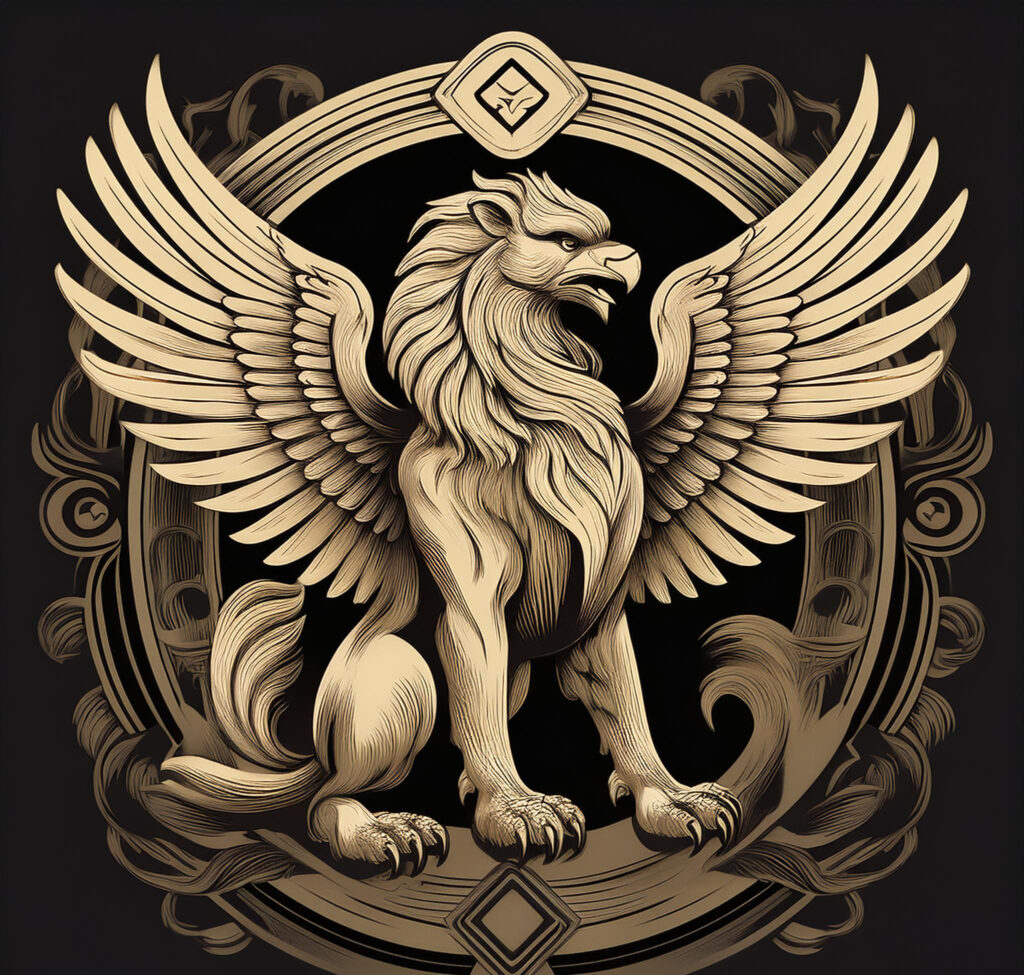
The origins of the griffin symbol trace back thousands of years to ancient civilizations where this mythical creature first appeared in art and literature. The griffin, with its lion’s body and eagle’s head, is one of the oldest and most enduring symbols in human history, representing a blend of strength and wisdom. The griffin’s enduring presence in various cultures parallels the longevity and significance of the Kosher Symbol, both serving as timeless emblems that convey important values and standards across generations.
The earliest known depictions of the griffin can be found in the art of ancient Mesopotamia, particularly in Sumerian and Akkadian cultures, around 3000 BCE. In these early representations, the griffin was often portrayed as a guardian figure, protecting palaces, temples, and other sacred spaces. Its role as a protector in these ancient societies laid the foundation for the griffin’s symbolic association with guardianship and divine protection.
As trade and cultural exchanges expanded across ancient civilizations, the griffin symbol spread to Egypt and Persia, where it took on additional meanings. In ancient Egypt, griffins were associated with the sun god Ra and were believed to have a protective role in the afterlife, guarding the pharaohs’ tombs. In Persian culture, the griffin became a symbol of divine power and royal authority, often appearing in the royal art and architecture of the Achaemenid Empire.
The griffin’s prominence continued to grow in ancient Greece, where it became an important symbol in mythology and art. Greek writers and artists depicted the griffin as a powerful and fearsome creature, often associated with the god Apollo. According to Greek myth, griffins guarded the gold of the Hyperboreans, a mythical people living far to the north. This connection to treasure and wealth added another layer to the griffin’s symbolism, reinforcing its role as a guardian of valuable resources.
Over time, the image and meaning of the griffin evolved, influenced by the cultures it touched. While its origins are deeply rooted in ancient Mesopotamia, the griffin’s symbolism expanded and transformed as it traveled across the ancient world. Despite these changes, the core attributes of strength, protection, and divine authority have remained central to the griffin’s identity throughout history.
In conclusion, the origins of the griffin symbol are a testament to its enduring power and versatility. From ancient Mesopotamia to Greece and beyond, the griffin has maintained its status as a symbol of strength, guardianship, and divine protection, embodying a rich and complex legacy that continues to captivate the imagination.
Mythological Significance of the Griffin
The griffin holds a prominent place in the mythologies of various ancient cultures, where it is revered as a powerful and mystical creature. Its unique combination of a lion’s body and an eagle’s head and wings symbolizes a fusion of strength, authority, and divine insight. These characteristics have contributed to the griffin’s enduring presence in mythological stories and its role as a symbol of deep significance.
In Greek mythology, the griffin is often associated with the god Apollo, known for his dominion over the sun, music, and prophecy. Griffins were believed to guard the treasures of the Hyperboreans, a mythical people living in a land far to the north, where the sun shone 24 hours a day. This connection to Apollo and the sun imbued the griffin with a sense of sacred duty and divine power, symbolizing the protection of valuable resources and knowledge.
The griffin’s role as a guardian is not limited to Greek mythology. In ancient Persian culture, the griffin was considered a protector of the divine and a symbol of royal authority. Often depicted alongside kings and deities, the griffin’s presence in Persian art and architecture reinforced its association with the divine right to rule and the safeguarding of the realm. This symbolism emphasized the griffin’s role as a protector of both the physical and spiritual worlds.
In Egyptian mythology, the griffin was closely linked to the sun god Ra and was often depicted as a creature that embodied the power and majesty of the sun. The griffin’s connection to Ra reinforced its association with life, light, and the eternal struggle against darkness. This connection also made the griffin a symbol of rebirth and renewal, reflecting the daily cycle of the sun rising and setting.
Beyond its role as a guardian and protector, the griffin was also seen as a symbol of balance and harmony. The combination of the lion, the king of beasts, and the eagle, the king of birds, represents the unification of earthly and celestial powers. This duality made the griffin a symbol of the balance between the material and spiritual worlds, emphasizing the importance of maintaining harmony in life.
In various cultures, the mythological significance of the griffin extends to its role as a mediator between the divine and human realms. It was believed to possess wisdom and knowledge that transcended the ordinary, making it a creature that could guide and protect those who sought higher understanding. This aspect of the griffin’s symbolism highlights its connection to enlightenment and the pursuit of spiritual truth.
In summary, the griffin’s mythological significance is rich and varied, reflecting its multifaceted role as a guardian, protector, and symbol of divine authority. Across different cultures, the griffin has been revered for its strength, wisdom, and ability to bridge the gap between the earthly and the divine, making it one of the most powerful and enduring symbols in mythology.
The Griffin as a Symbol of Power and Protection
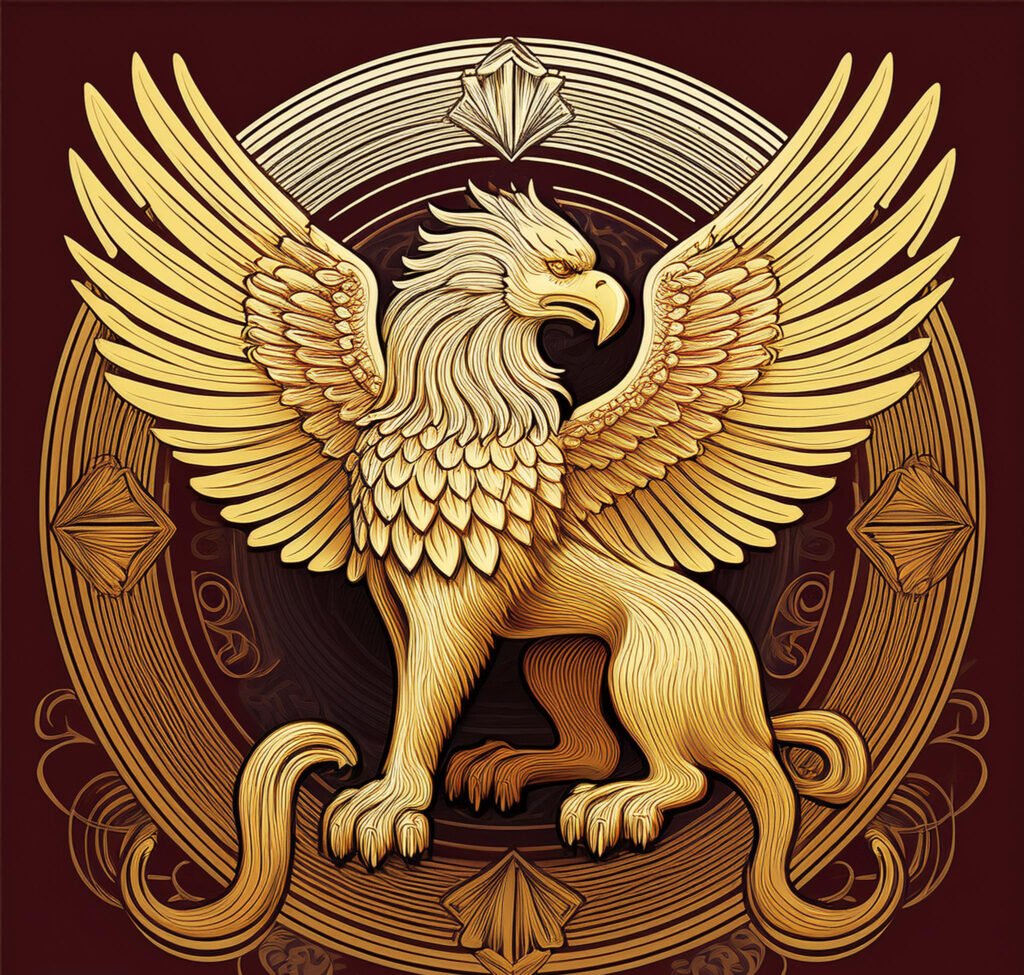
The griffin has long been recognized as a symbol of power and protection, embodying the qualities of both the lion and the eagle—two of the most revered creatures in the animal kingdom. This mythical creature’s dual nature, combining the strength and authority of the lion with the sharp vision and divine connection of the eagle, has made it a potent emblem in various cultures throughout history.
The lion, often referred to as the “king of beasts,” is a universal symbol of strength, courage, and dominance. As the embodiment of these traits, the griffin inherits the lion’s reputation as a powerful and authoritative figure, capable of commanding respect and instilling fear in those who would challenge it. This association with the lion solidifies the griffin’s role as a protector, a guardian of both physical and spiritual realms.
The eagle, with its soaring flight and keen vision, represents freedom, vigilance, and a connection to the divine. By incorporating the eagle’s head and wings, the griffin not only gains the attributes of sharp perception and insight but also embodies the protective oversight of the heavens. This celestial connection enhances the griffin’s role as a protector, suggesting that it watches over those under its care with divine wisdom and foresight.
Throughout history, the griffin has been depicted as a guardian of treasures, both material and spiritual. In many myths and legends, griffins are portrayed as fierce protectors of gold and precious stones, often found in remote and sacred locations. This protective role extends beyond mere physical wealth; the griffin is also seen as a guardian of knowledge, wisdom, and sacred truths, defending them from those who might misuse or defile them.
In heraldry, the griffin is a common symbol on coats of arms, where it represents bravery, strength, and vigilance. Knights and noble families often adopted the griffin as a heraldic symbol to convey their power and their role as protectors of their people and lands. The griffin’s image on a shield or banner served as a powerful reminder of the bearer’s duty to protect and uphold justice, both in battle and in governance.
The griffin’s association with power and protection also extends to its role in religious and spiritual contexts. In ancient civilizations, griffins were often placed at the entrances of temples, palaces, and tombs to guard against evil spirits and protect sacred spaces. Their presence was believed to ensure the safety and sanctity of these sites, reinforcing the idea that the griffin was not only a physical protector but also a spiritual guardian.
In conclusion, the griffin as a symbol of power and protection is deeply rooted in its dual nature, combining the best qualities of the lion and the eagle. Whether guarding treasures, protecting the sanctity of sacred spaces, or serving as a heraldic emblem of authority and bravery, the griffin remains a powerful symbol of strength, vigilance, and guardianship across cultures and throughout history.
Griffin in Heraldry
In the intricate world of heraldry, the griffin stands out as one of the most powerful and revered symbols. Combining the attributes of both the lion and the eagle, the griffin represents a unique blend of strength, courage, vigilance, and protection—qualities highly valued in the medieval societies where heraldry flourished.
Heraldry, the practice of designing and displaying coats of arms and other armorial bearings, served as a visual language that conveyed the values, lineage, and achievements of noble families, knights, and royalty. The griffin, with its fearsome appearance and rich symbolic heritage, became a popular choice for those seeking to project an image of authority and guardianship.
The griffin’s lion-like body, representing the king of beasts, symbolizes unmatched strength, bravery, and leadership. These traits were particularly important for knights and noble families who wished to assert their dominance and protect their domains. The griffin’s association with the lion conveyed a message of martial prowess and the ability to command and defend.
The eagle, represented by the griffin’s head and wings, added another layer of symbolism, signifying keen vision, freedom, and a connection to the divine. In heraldic traditions, the eagle is often seen as a symbol of the heavens, watching over the earth with sharp eyes and providing protection from above. By incorporating the eagle’s attributes, the griffin in heraldry suggested that the bearer was not only powerful on the battlefield but also guided by wisdom and divine favor.
The griffin’s role as a guardian is a central theme in heraldic symbolism. Often depicted with wings spread and claws ready to strike, the griffin on a coat of arms conveyed a sense of vigilance and readiness to protect what was most valuable—whether it be territory, wealth, or honor. This protective symbolism made the griffin an ideal emblem for those who viewed themselves as defenders of their people, lands, and traditions.
In some heraldic designs, the griffin is shown holding a sword, further emphasizing its role as a warrior and protector. This imagery reinforced the idea that the bearer was not only noble by birth but also prepared to fight for justice and the preservation of their realm.
The griffin’s popularity in heraldry was not limited to any single region; it was embraced across Europe, appearing in the coats of arms of various noble families, cities, and military orders. The versatility of the griffin as a symbol allowed it to be adapted to different contexts, while its powerful imagery ensured that it remained a compelling and respected emblem throughout the centuries.
In conclusion, the griffin in heraldry symbolizes the perfect blend of strength, courage, and vigilance. Its presence on a coat of arms communicated the bearer’s commitment to protecting their legacy and upholding the values of their lineage. As a heraldic symbol, the griffin remains an enduring representation of noble virtues and the timeless principles of guardianship and leadership.
Griffin as a Guardian of Treasures
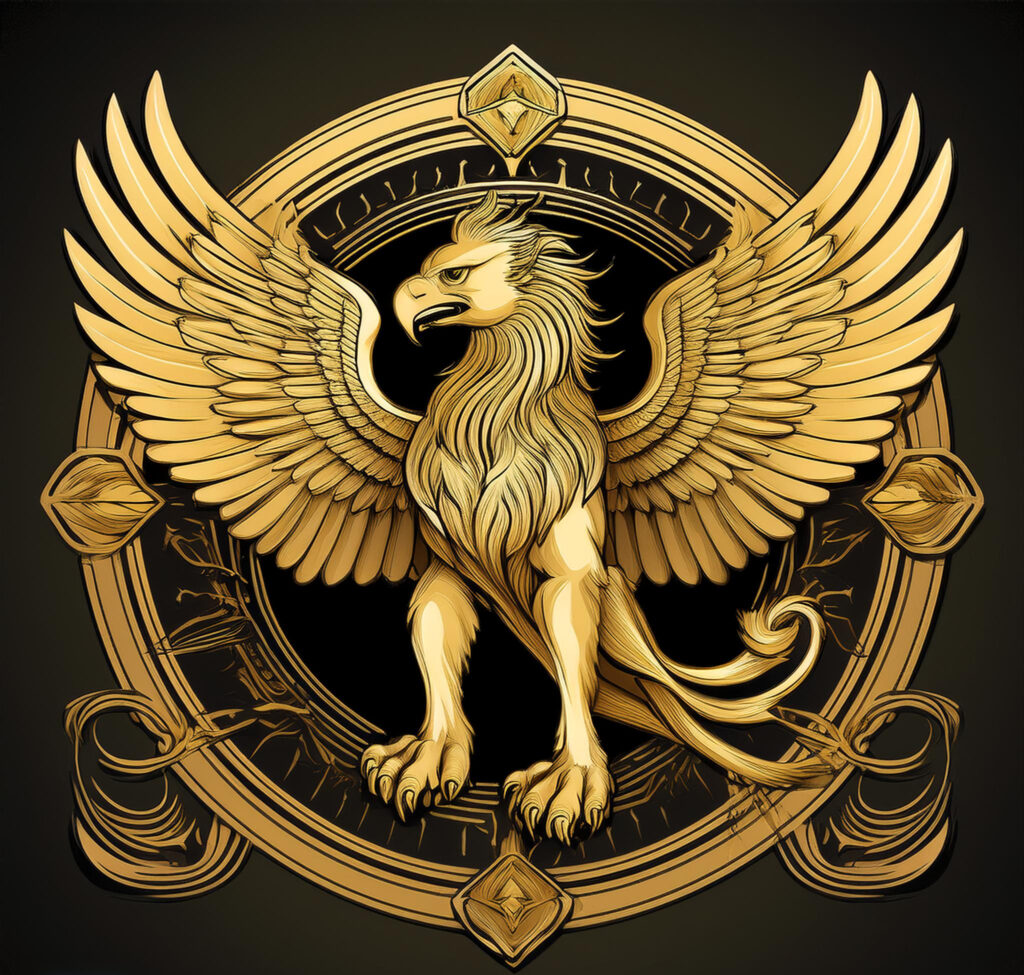
The image of the griffin as a fierce guardian of treasures is a recurring theme in mythology and legend. This mythical creature, with the body of a lion and the head and wings of an eagle, is not only a symbol of power and protection but also a vigilant sentinel of the most valuable and sacred possessions. The griffin’s role as a protector of treasures has captivated the imagination for centuries, contributing to its enduring presence in art, literature, and folklore.
The origins of the griffin as a guardian of treasures can be traced back to ancient times, particularly in the myths of the Greeks and Persians. In Greek mythology, griffins were believed to guard vast hoards of gold in the distant lands of the Hyperboreans, a mythical people who lived beyond the reach of ordinary mortals. These treasures, said to be buried deep within the mountains, were fiercely protected by griffins, who were known for their unmatched strength and relentless vigilance. Anyone who dared to approach these hidden riches would face the wrath of the griffin, ensuring that only those deemed worthy could access the wealth.
In Persian culture, the griffin was also revered as a guardian of treasures, both earthly and divine. Persian art and literature often depicted griffins as protectors of royal treasures and sacred relics. These powerful creatures were believed to be invincible in battle, using their lion-like strength and eagle-eyed vision to defend their charges from any threat. The griffin’s presence as a guardian symbolized the protection of not just material wealth but also the spiritual and cultural heritage of the people.
The connection between griffins and treasure guardianship is further emphasized in medieval European folklore, where the griffin became a popular symbol in stories of hidden treasures and lost riches. Tales of knights and adventurers seeking out griffin-guarded treasures were common, with the griffin representing both the challenge and the reward of such quests. The griffin’s formidable presence and the difficulty of overcoming it added a sense of awe and mystery to these tales, making the treasure it guarded even more desirable.
In addition to material wealth, the griffin was often associated with guarding spiritual treasures and sacred knowledge. In many cultures, treasures were not limited to gold and jewels but also included sacred texts, religious relics, and other objects of profound significance. The griffin’s role as a guardian extended to these spiritual treasures, protecting them from desecration and ensuring that only those with pure intentions could access them. This aspect of the griffin’s symbolism highlights its connection to wisdom, enlightenment, and the preservation of sacred truths.
The griffin’s reputation as a guardian of treasures has also influenced its depiction in art and heraldry. Often shown with claws gripping a treasure chest or standing watch over a pile of gold, the griffin serves as a powerful reminder of the value of what it protects. This imagery reinforces the idea that the griffin is not only a physical protector but also a symbol of the sacred responsibility to safeguard what is precious, whether it be material wealth, knowledge, or spiritual integrity.
In conclusion, the griffin as a guardian of treasures is a symbol rich in meaning and history. Its role as a protector of both earthly and spiritual riches has made it a timeless figure in mythology and folklore, embodying the values of strength, vigilance, and the sacred duty to protect what is most valuable.
Griffin in Modern Culture
The griffin, with its majestic combination of lion and eagle, has transcended ancient mythology to become a powerful and enduring symbol in modern culture. While its roots lie in the myths and legends of ancient civilizations, the griffin continues to captivate the imagination today, appearing in various forms of media, literature, art, and popular culture.
In literature, the griffin remains a popular figure in fantasy and adventure genres. Authors often incorporate griffins into their stories as guardians of mystical lands, protectors of ancient treasures, or allies to heroes on epic quests. These depictions build on the griffin’s traditional symbolism of strength, protection, and wisdom, making it an ideal creature for fantastical narratives. Books and novels frequently explore the dual nature of the griffin, emphasizing its fierce loyalty and formidable presence.
The griffin has also made its mark in the world of cinema and television. From fantasy films to animated series, the griffin is often portrayed as a noble and awe-inspiring creature, embodying the ideals of courage and guardianship. In many instances, the griffin serves as a symbol of hope or as a powerful ally to protagonists facing great challenges. Its appearance on screen continues to reinforce the timeless allure of the griffin, bridging the gap between ancient mythology and contemporary storytelling.
In addition to literature and film, the griffin has become a popular symbol in video games and tabletop role-playing games. Players frequently encounter griffins as powerful adversaries or valuable companions in their virtual adventures. These representations often emphasize the griffin’s strength, agility, and ability to traverse both land and sky, making it a versatile and formidable creature in gameplay. The griffin’s presence in these games reflects its enduring appeal as a symbol of power and protection, resonating with players who seek to embody these qualities in their characters.
The influence of the griffin extends beyond entertainment into corporate branding and logos. Many companies and institutions have adopted the griffin as part of their visual identity, using it to convey qualities such as strength, reliability, and guardianship. The griffin’s regal and authoritative appearance makes it an ideal symbol for brands that wish to project a sense of trustworthiness and excellence. Its use in logos and emblems ensures that the griffin remains a recognizable and respected figure in modern commerce.
Art and design have also embraced the griffin as a source of inspiration. Contemporary artists often draw on the griffin’s rich history and symbolic meaning to create works that explore themes of duality, protection, and the balance between earthly and spiritual realms. The griffin’s striking appearance and symbolic depth make it a compelling subject for visual exploration, allowing artists to reinterpret this ancient creature in new and innovative ways.
In the realm of education and academia, the griffin has found a place as a mascot for schools, universities, and sports teams. As a symbol of strength, wisdom, and guardianship, the griffin represents the values of knowledge, perseverance, and leadership—qualities that educational institutions strive to instill in their students. The griffin’s presence as a mascot serves to inspire and motivate, linking the pursuit of excellence with the storied legacy of this mythical creature.
In conclusion, the griffin’s continued presence in modern culture is a testament to its enduring power and versatility as a symbol. Whether in literature, film, gaming, branding, art, or education, the griffin remains a potent emblem of strength, protection, and wisdom. Its ability to transcend time and adapt to contemporary contexts ensures that the griffin will continue to be a beloved and influential figure for generations to come.
What Symbols Do Our Readers Ask About?
Our readers are deeply interested in the rich and varied world of symbols, and their questions often lead us to explore fascinating and diverse topics. The curiosity and engagement of our audience drive us to delve into the meanings behind some of the most intriguing symbols across different cultures and time periods. Here are some of the symbols our readers frequently ask about:
1. The Phoenix
One of the most popular symbols our readers inquire about is the phoenix, a mythical bird that rises from its ashes. The phoenix is often associated with themes of rebirth, immortality, and renewal. Readers are intrigued by its ability to represent both the destruction of the old and the birth of the new, making it a powerful symbol of transformation and resilience.
2. The Ouroboros
The image of the ouroboros, a serpent eating its own tail, is another symbol that captures the interest of our audience. This ancient symbol, which originates from Egyptian and Greek mythology, represents the concept of eternal cycles, unity, and the infinite nature of the universe. Our readers are fascinated by how this symbol reflects the interconnectedness of life and the continuous process of creation and destruction.
3. The Tree of Life
The Tree of Life is a symbol that appears in various cultures and religious traditions, often representing growth, connection, and the interdependence of all life. Our readers frequently ask about its different interpretations, from its roots in ancient mythology to its modern-day significance in spiritual practices. The Tree of Life’s universal appeal and deep meaning make it a favorite topic for exploration.
4. The Ankh
The Egyptian ankh, also known as the “key of life,” is a symbol that continues to intrigue our readers. Often associated with life, immortality, and the divine, the ankh is a powerful emblem in ancient Egyptian culture. Readers are particularly interested in how the ankh was used in religious rituals and its lasting impact on contemporary symbols of life and eternity.
5. The Eye of Horus
Another symbol from ancient Egypt that garners significant interest is the Eye of Horus, a symbol of protection, health, and restoration. Our readers are captivated by the mythological stories surrounding this symbol, as well as its use as an amulet in ancient times to ward off evil. The Eye of Horus continues to be a popular topic due to its deep roots in symbolism and its enduring legacy in modern culture.
6. The Mandala
Mandalas, intricate geometric designs representing the universe, are frequently asked about by our readers. Originating in Hindu and Buddhist traditions, mandalas symbolize unity, balance, and harmony. Our audience is drawn to the meditative and spiritual qualities of mandalas, often exploring how they can be used as tools for personal growth and self-discovery.
7. The Labyrinth
The labyrinth, a complex maze-like symbol, is another topic of interest for our readers. Representing a journey or path to enlightenment, the labyrinth is seen in various cultures as a metaphor for the challenges and discoveries of life. Readers are fascinated by the symbolic significance of walking a labyrinth as a spiritual practice and its use in rituals throughout history.
8. The Griffin
Of course, the griffin itself is a symbol that draws considerable attention. Our readers are particularly interested in its dual nature, combining the strengths of both the lion and the eagle, and its role as a guardian of treasures and protector of the divine. The griffin’s enduring presence in mythology and heraldry continues to inspire curiosity and admiration.
These are just a few of the symbols that our readers frequently ask about. Their diverse interests reflect a shared passion for uncovering the meanings behind the symbols that have shaped human culture and consciousness for centuries. We are committed to exploring these symbols in depth, providing our readers with insights and interpretations that enrich their understanding of the world of symbolism.
Similar Symbols to the Griffin
The griffin, with its unique combination of lion and eagle traits, is a powerful symbol of strength, protection, and guardianship. However, it is not the only creature in mythology and folklore that carries these attributes. Many other mythical beings share similar qualities and symbolic meanings. Below is a comparison of the griffin with other similar symbols found in various cultures.
| Symbol | Description | Symbolism | Culture of Origin |
|---|---|---|---|
| Sphinx | A creature with the body of a lion and the head of a human, often associated with riddles and wisdom. | Guardian of knowledge and protector of sacred spaces. | Ancient Egypt, Greece |
| Hippogriff | A mythical creature with the front half of an eagle and the hind half of a horse, representing the union of opposites. | Courage, honor, and the blending of different elements. | Medieval Europe |
| Chimera | A monstrous creature with the head of a lion, the body of a goat, and the tail of a serpent, often depicted as a fearsome guardian. | Chaos, destruction, and the power of transformation. | Ancient Greece |
| Simurgh | A benevolent bird-like creature with immense wisdom, often depicted with the body of a lion or a dog and the wings of a bird. | Healing, protection, and the link between heaven and earth. | Persian Mythology |
| Dragon | A large, serpentine creature often associated with fire-breathing and immense power, symbolizing authority and protection. | Power, strength, and protection; sometimes chaos. | Various cultures worldwide |
| Garuda | A mythical bird or bird-like creature, often depicted with human features, known for its role as the mount of the god Vishnu. | Courage, strength, and protection against evil. | Hindu and Buddhist Mythology |
| Lion | A common symbol in various mythologies, representing courage, strength, and nobility, often seen as a guardian figure. | Royalty, courage, and protection. | Various cultures worldwide |
| Eagle | A bird of prey often associated with the sky, freedom, and divine connection, symbolizing sharp vision and authority. | Vision, authority, and the link between heaven and earth. | Various cultures worldwide |
Each of these symbols shares certain characteristics with the griffin, whether it’s their role as protectors, their composite nature, or their association with power and wisdom. The comparison highlights how different cultures have interpreted similar themes through the creation of these mythical beings, each with its own unique blend of qualities and symbolism.
Frequently Asked Questions (FAQ)
As the griffin continues to capture the imagination of people across the world, it’s no surprise that many questions arise about this fascinating creature. Below are some of the most frequently asked questions we receive from our readers about the griffin, along with detailed answers to help deepen your understanding of this powerful symbol.
The griffin is a symbol of strength, courage, protection, and guardianship. Combining the attributes of the lion and the eagle, it represents the union of earthly power and heavenly vision. Throughout history, the griffin has been seen as a protector of treasures, a guardian of the divine, and an emblem of authority and leadership.
The myth of the griffin is believed to have originated in ancient Mesopotamia, where early depictions of eagle-lion hybrids can be found. The legend spread to ancient Greece and Rome, where the griffin became associated with protecting the gold of the Hyperboreans. Over time, the griffin’s mythos expanded across Europe, Persia, and other cultures, solidifying its place in global mythology.
In art and heraldry, the griffin is typically depicted with the body of a lion, the head and wings of an eagle, and sometimes with the talons of an eagle. It often appears in coats of arms, where it symbolizes courage, vigilance, and strength. The griffin is also commonly shown in a pose of attack or as a guardian, emphasizing its protective nature.
Yes, variations of the griffin exist in different cultures. For example, the Hippogriff, a creature with the front half of an eagle and the hind half of a horse, is a variation that emerged in medieval European mythology. Additionally, some depictions of griffins include additional features like serpent tails or additional wings, reflecting regional interpretations of the creature.
The griffin remains a popular symbol in modern culture, appearing in literature, films, video games, and as logos for various organizations. It continues to represent strength, protection, and a connection between the earthly and the divine. In contemporary fantasy genres, griffins are often depicted as noble creatures or powerful guardians, maintaining their legendary status.
The association of the griffin with guarding treasures likely stems from its dual nature, combining the lion’s power with the eagle’s keen vision. In ancient myths, griffins were believed to protect vast hoards of gold and sacred objects, ensuring that only the worthy could access them. This role as a guardian of valuable items has carried through to modern interpretations, where the griffin is often seen as a symbol of protection and guardianship over what is precious.
While the griffin is primarily a figure of myth and legend, it does appear in some religious and spiritual contexts, particularly in medieval Christian symbolism. The griffin’s combination of lion and eagle attributes made it a powerful symbol of Christ’s dual nature—both human and divine. In this context, the griffin was sometimes used in religious art and literature to convey spiritual themes.

I’m the editor at SymbolsSays, where I explore the deeper meanings of symbols in mythology, art, literature, and psychology. My goal is to provide insights into how symbols influence our lives and connect us to our past.
